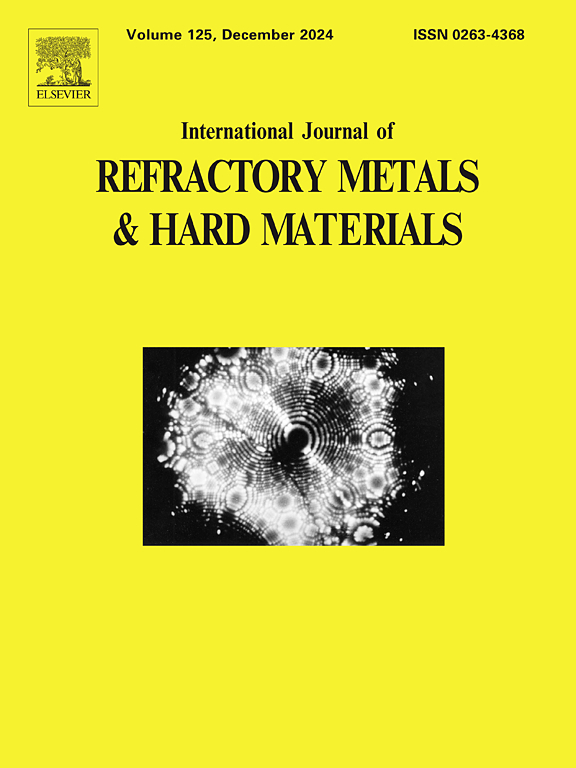Effect of Si additions on the oxidation behavior of AlMo0.5NbTiVSix refractory high-entropy alloys at 1073 K
IF 4.2
2区 材料科学
Q2 MATERIALS SCIENCE, MULTIDISCIPLINARY
International Journal of Refractory Metals & Hard Materials
Pub Date : 2025-04-19
DOI:10.1016/j.ijrmhm.2025.107198
引用次数: 0
Abstract
In this study, AlMo0.5NbTiVSix (x = 0, 0.1, 0.2, 0.3, 0.4, and 0.5) refractory high-entropy alloys were fabricated by vacuum arc-melting, and the effects of Si on the oxidation resistance were systematically investigated. The results indicate that the oxidation behavior of alloys without Si addition primarily involved metal-gas interface reactions and solid-solution diffusion through the oxide layer. After the introduction of the Si element, Si formed the M5Si3-type intermetallic compound phase with Ti and Nb attributed to their strong bonding ability and acted as a short-circuit diffusion channel, contributing to the accelerated corrosion of oxygen on the interior of the alloy during the oxidation process. In addition to the metal-gas interface reaction and solid-solution diffusion through the oxide layer, the oxidation behavior of Si-containing RHEAs in our study also comprised the influence of the phase interface, suggesting that the nucleation sites of the oxide included the phase interface between BCC and M5Si3 phase. High Si content was not conducive to the antioxidant performance of RHEAs. Furthermore, the oxidation products and mechanisms of AlMo0.5NbTiVSix alloys were discussed from a thermodynamic perspective.
Si添加量对AlMo0.5NbTiVSix难熔高熵合金1073 K氧化行为的影响
本研究采用真空电弧熔炼法制备了AlMo0.5NbTiVSix (x = 0、0.1、0.2、0.3、0.4、0.5)耐火高熵合金,系统研究了Si对其抗氧化性能的影响。结果表明,未添加Si的合金的氧化行为主要涉及金属-气体界面反应和氧化层固溶扩散。Si元素引入后,由于Ti和Nb的结合能力强,Si与它们形成m5si3型金属间化合物相,并作为短路扩散通道,在氧化过程中加速了氧对合金内部的腐蚀。本研究中含硅RHEAs的氧化行为除了受金属-气界面反应和固溶扩散的影响外,还受相界面的影响,表明氧化物的成核位点包括BCC与M5Si3相之间的相界面。高Si含量不利于RHEAs的抗氧化性能。并从热力学角度探讨了AlMo0.5NbTiVSix合金的氧化产物和氧化机理。
本文章由计算机程序翻译,如有差异,请以英文原文为准。
求助全文
约1分钟内获得全文
求助全文
来源期刊
CiteScore
7.00
自引率
13.90%
发文量
236
审稿时长
35 days
期刊介绍:
The International Journal of Refractory Metals and Hard Materials (IJRMHM) publishes original research articles concerned with all aspects of refractory metals and hard materials. Refractory metals are defined as metals with melting points higher than 1800 °C. These are tungsten, molybdenum, chromium, tantalum, niobium, hafnium, and rhenium, as well as many compounds and alloys based thereupon. Hard materials that are included in the scope of this journal are defined as materials with hardness values higher than 1000 kg/mm2, primarily intended for applications as manufacturing tools or wear resistant components in mechanical systems. Thus they encompass carbides, nitrides and borides of metals, and related compounds. A special focus of this journal is put on the family of hardmetals, which is also known as cemented tungsten carbide, and cermets which are based on titanium carbide and carbonitrides with or without a metal binder. Ceramics and superhard materials including diamond and cubic boron nitride may also be accepted provided the subject material is presented as hard materials as defined above.

 求助内容:
求助内容: 应助结果提醒方式:
应助结果提醒方式:


